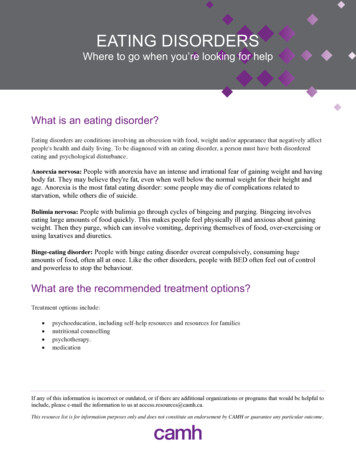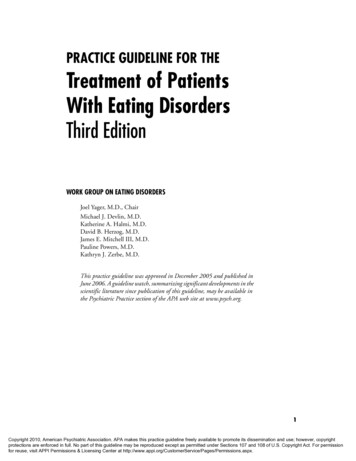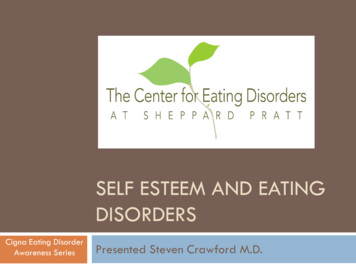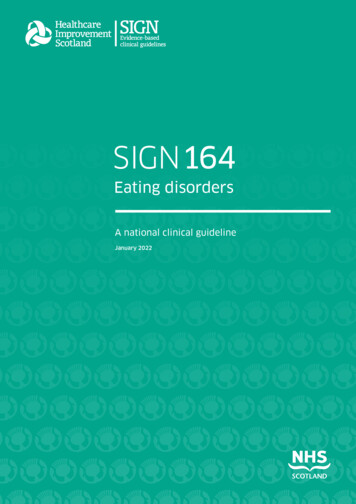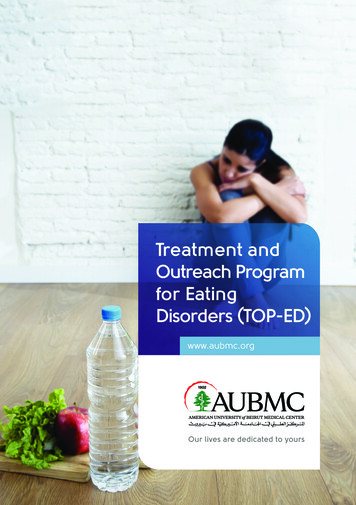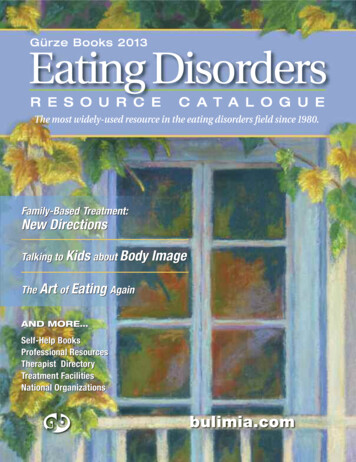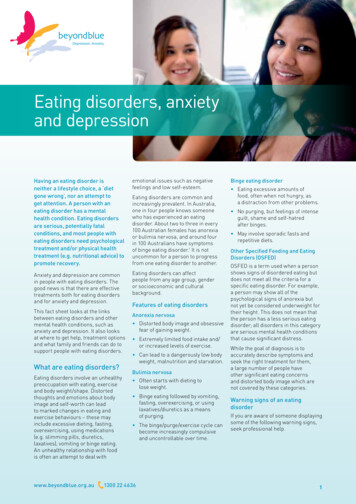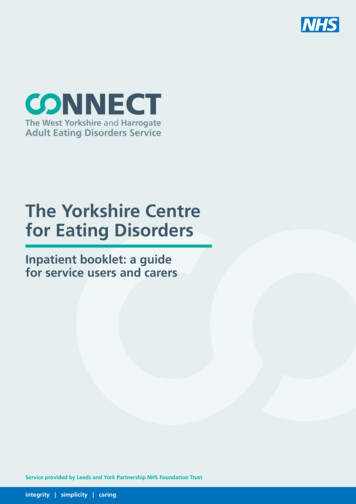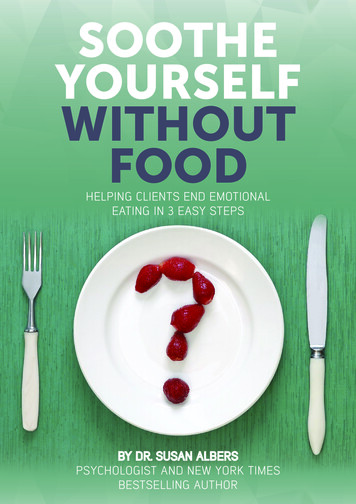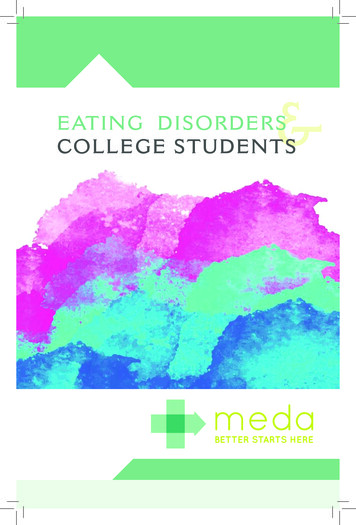
Transcription
&EATING DISORDERSCOLLEGE STUDENTS
TABLE OF CONTENTSFactors That May Contribute to an Eating Disorder2Eating Disorder Myths4College Students & Eating Disorders6About Eating Disorders8Do’s and Don’ts of Helping a Friend12Eating Disorder Statistics14Do You Have a Healthy Relationship with Food and Your Body?16Contact Information18MEDA’s Programs & Services19MEDA’s Support Groups20MEDA’s Partners21BETTER STARTS HERE WWW.MEDAINC.ORG1
FACTORS THAT MAY CONTRIBUTETO AN EATING DISORDEREating disorders are complex conditions thatarise from a combination of long-standing behavioral, biological, emotional, psychological,interpersonal, and social factors. Scientistsand researchers are still learning about theunder lying causes of these conditions.Wedo know, however, about some of the generalissues that can contribute to the developmentof eating disorders.While eating disorders may first appear to besolely about food and weight preoccupations,those suffering from them often try to use foodand the control of food to cope with feelingsand emotions that may otherwise seem overwhelming. For some, dieting, bingeingand purging may begin as a way to cope withpainful emotions and to feel in control of one’slife. These behaviors can damage a person’sphysical and emotional health, self-esteemand sense of competence and control.2
BIOLOGICAL FACTORS: Scientists are still researching possible biochemical or biological causesof eating disorders. In some individuals with eating disorders, certain chemicals in the brain that control hunger, appetite, and digestionhave been found to be unbalanced Eating disorders often run in families. Current research indicates thatthere are significant genetic contributions to eating disordersPSYCHOLOGICAL FACTORS: Low self-esteem Feelings of inadequacy or lack of control in life Depression, anxiety, anger, stress or lonelinessINTERPERSONAL FACTORS: Troubled personal relationships Difficulty expressing emotions and feelings History of being teased or ridiculed based on size or weight History of physical or sexual abuseSOCIAL FACTORS: Cultural pressures that glorify thinness or muscularity and place valueon obtaining the “perfect body” Narrow definitions of beauty that include only specific body weightsand shapes Cultural norms that value people on the basis of physical appearanceand not inner qualities and strengths Stress related to discrimination or prejudiceBETTER STARTS HERE 617.558.18813
EATING DISORDER MYTHSMYTH: EATING DISORDERSARE NOT AN ILLNESSTRUTH: Eating disorders are a complex medical/ psychiatric illness. Eating disorders are classifiedas a mental illness in the American Psychiatric Association’s Diagnostic and Statistical Manual ofMental Health (DSM-V). They are considered to often have a biologic basis and co-occur with othermental illnesses such as major depression, anxiety orobsessive- compulsive disorder.MYTH: EATING DISORDERSARE UNCOMMONTRUTH: Among U.S. females in their teens and 20s,the prevalence of clinical and subclinical Anorexiamay be as high as 15%. Anorexia ranks as the 3rdmost common chronic illness among adolescentU.S. females. Recent studies suggest that up to 7%of U.S. females have had Bulimia at some time intheir lives. At any given time an estimated 5% of theU.S. population has undiagnosed Bulimia. Currentfindings suggest that Binge Eating Disorder affects0.7% to 4% of the general population.4
MYTH: EATING DISORDERS ARE A CHOICETRUTH: People do not choose to have eating disorders. Eating disordersdevelop over time and require appropriate treatment to address thecomplex medical/psychiatric symptoms and underlying issues.MYTH: EATING DISORDERS OCCUR ONLYIN FEMALESTRUTH: An estimated 25% of Anorexia diagnoses in children arein males. For Binge Eating Disorder, preliminary research suggestsequal prevalence among males and females. Incidence in males may beunderreported because research shows that females are more likely toseek help. Also, health practitioners are more likely to consider an eating disorder diagnosis in females.MYTH: YOU CAN TELL IF A PERSON HAS ANEATING DISORDER SIMPLY BY APPEARANCETRUTH: You can’t. Anorexia may be easier to detect visually, althoughi ndividuals may wear loose clothing to conceal their body. Bulimia isharder to “see” because individuals often are average weight. Peoplewith an eating disorder can become very effective at hiding the signsand symptoms. Eating disorders can go undetected for months, yearsor a lifetime.MYTH: A PERSON CANNOT DIE FROM BULIMIATRUTH: While the rate of death from Bulimia is much lower than thatseen with Anorexia, a person with Bulimia can be at high risk for deathand sudden death because of purging and its impact on the heart andelectrolyte imbalances. Various purging techniques and excessive exercisecan increase risk of death in individuals who are actively bulimic.BETTER STARTS HERE WWW.MEDAINC.ORG5
COLLEGE STUDENTS &EATING DISORDERSWHY ARE COLLEGE STUDENTSSUSCEPTIBLE TO DEVELOPINGEATING DISORDERS? New peer groups Difficulty forming new friendships New found self-reliance; no longer living under parental rules Eating in a cafeteria with an unlimited amountof food; making food choices may be difficult Fear of the “Freshman 15” Dorm-living The need to fit in Too many commitments Academic and financial stress Intense pressures to be thin/ “perfect” Difficulty managing transitions6A 2006 survey bythe National Eating Disorders Association(NEDA) found thatnearly 20% of themore than 1,000 collegestudents surveyed —both male and female —said they have orpreviously had aneating disorder
WHY ARE COLLEGE STUDENTS NOT SEEKINGTREATMENT? Unwilling to seek treatment Do not know that they have an eating disorder Lack of awareness of treatment resources Embarrassed to seek treatment Lack of treatment resources Perceived lack of anonymity in treatment Lack of knowledge by college staff about where to refer studentsWHAT CAN COLLEGES DO TO HELP TREAT ANDPREVENT EATING DISORDERS? Form a body image/eating disorder group that is run by studentsand/or faculty Assist in education, prevention and activism on campus Promote as many food choices as possible in the cafeteria (optionsmay include a soup and salad bar, deli, pasta bar, fruit stand and/orfrozen yogurt machine) On- campus dietitian should be available, as well as counseling andhealth services staffBETTER STARTS HERE 617.558.18817
ABOUT EATING DISORDERSEating disorders claim as many as 11 million lives eachyear. With the highest mortality rate of any mental illness, eating disorders continue to be a major part ofour culture. According to the Diagnostic and StatisticalManual – Fifth Edition (DSM-V), eating disordersare classified into four major categories: Anorexia, Bulimia, Binge Eating Disorder, and Other SpecifiedFeeding or Eating Disorders.STATISTICSAnorexiaBetween 0.5–1% ofAmerican womensuffer from anorexia. Intense fear of weight gain, obsession with weightand persistent behavior to prevent weight gainBetween 5-20% of individuals strugglingwith Anorexia will die.The probabilities of deathincrease within thatrange dependingon the length ofthe condition. Self-esteem overly related to body imageBulimia Preoccupation with weight, food, calories,fat grams, and dietingBulimia affects 1-2% ofadolescent and youngadult women.ANOREXIASigns & Symptoms Frequent comments about feeling “fat” oroverweight despite weight loss Development of food rituals (e.g. eating foods incertain orders, excessive chewing, rearrangingfood on a plate) Consistent excuses to avoid mealtimes or situations involving food8People struggling withBulimia usually appearto be of average bodyweight.Bulimia is frequently associated with symptomsof depression and changesin social adjustment.
Excessive, rigid exercise regimen--despite weather, fatigue, illness,or injury, the need to “burn off” calories taken in Withdrawal from usual friends and activitiesHEALTH CONSEQUENCESOF ANOREXIADue to the body being denied essential nutrients it needs to function,the body is forced to slow down all of its processes to conserve energy.This results in serious medical consequences such as: Slow heart rate or low blood pressure. There is a risk for heart failureas the heart rate and blood pressure levels decrease Osteoporosis or osteopenia Muscle loss and weakness Dehydration – if severe enough, it can result in kidney failure Fainting, fatigue, and overall weakness Dry hair and skin, hair loss can occur Growth of lanugo, a layer of hair all over the body, which develops inan effort to keep the body warmBULIMIASigns & Symptoms Frequent episodes of consuming very large amount of food (“bingeing”)followed by behaviors to prevent weight gain, such as self-inducedvomiting A feeling of being out of control during the binge eating episodes Unusual swelling of the cheeks or jaw area Evidence of binge eating, including disappearance of large amountsof food in short periods of time or finding wrappers and containerswhich can indicate the consumption of large amounts of food Evidence of purging behaviors, including frequent trips to the bathroomafter meals, signs and/or smells of vomiting, presence of wrappers orpackages of laxatives or diuretics In general, behaviors and attitudes indicating that weight loss, dieting,and control of food are becoming primary concernsBETTER STARTS HERE WWW.MEDAINC.ORG9
ABOUT EATING DISORDERSHEALTH CONSEQUENCESOF BULIMIAThe recurrent binge-and-purge cycles of Bulimiacan affect the entire digestive system and can leadto electrolyte and chemical imbalances in the bodythat affect the heart and other major organ functions.Some of the health consequences include: Electrolyte imbalances, from dehydration or otherfactors, that can lead to irregular heartbeats andpossibly heart failure and death Inflammation as well as potential rupture of the esophagus from frequent vomiting Tooth decay and staining due to frequent vomiting Peptic ulcers and/or pancreatitis Irregular bowel movements and constipation if laxatives are abusedBINGE EATING DISORDERSigns & Symptoms A feeling of being out of control during the bingeeating episodes Feelings of strong shame or guilt regarding thebinge eating10STATISTICSBinge EatingDisorderBinge Eating Disorder affects women slightlymore often than men— estimates indicatethat about 60% of peoplestruggling with BingeEating Disorder are female, 40% are male.The prevalence ofBinge Eating Disorderis estimated to beapproximately 1-5% ofthe general population.
Eating alone because of shame about the behavior Attributes social and professional successes/failures to weight gain/loss Eating large amounts of food when not physically hungry or eatinguncontrollably or to the point of discomfortHEALTH CONSEQUENCES OFBINGE EATING DISORDERBinge Eating Disorder often results in many of the same health risks associated with clinical obesity. Some of the potential health risksinclude: High blood pressure High cholesterol Heart disease as a result of high triglyceride levels Type II diabetes mellitus Gallbladder diseaseOTHER SPECIFIED FEEDING OR EATING DISORDERSPeople with “Other Specified Feeding or Eating Disorders” exhibit symptoms which do not meet the strict criteria for eating disorder diagnosis, although they may be very severe. Examples include: ATYPICAL ANOREXIA: All of the criteria for Anorexia are met, exceptsignificant weight loss. The individual’s weight is within or above thenormal range BULIMIA OR BINGE EATING DISORDER (of low frequency and/or limited duration): All of the criteria are met, except that the behaviorsoccur, on average, less than once a week and/or for less than 3 months PURGING DISORDER: Recurrent purging behavior to influence weightor shape in the absence of binge eating NIGHT EATING SYNDROME: Recurrent episodes of night eating, as manifested by eating after awakening from sleep or by excessivefood consumption after the evening mealBETTER STARTS HERE 617.558.188111
DO’S AND DON’TS OFHELPING A FRIENDDO Talk openly and honestly about concerns Try to make yourself available when theyneed someone Be honest about your own fears, struggles,and frustrations Take time to listen, even though the talk may seemtrivial or insignificant to you Understand that they are terrified of gainingweight and being fat (regardless of how they actually look to you) Focus on personality and positive characterqualities Encourage them to accept support and expresstheir feelings Avoid conflicts and battles of will Be patient; recovery can be a long process Know your limits and respect them12
DON’T Try to be their therapist; enlist professional help Be afraid to upset them; communicate openly Ignore them; they need support from family and friends Offer simple solutions (“why don’t you just eat?!”) Comment on their weight (if you say “you look too thin”, they may take it asa compliment; if you say “you look healthy” they may take it as an insult) Blame them or make them feel ashamed or guilty for having aneating disorder Threaten (“if you don’t eat ”) Use “you” statements, because they sound accusatory. Instead, try starting your sentence with “I see it this way.” Expect an instant recovery Try to force them to eat or stop exercising Focus on food, weight, or appearanceMOST IMPORTANTLY, REMEMBER TO ACT NOW!AAsk to speak with your friend privatelyCConfront with concern and careTTell your friend what you see that makes you concernedNNever continue the conversation if either of you becomestoo emotionalOOnly professionals can diagnose, so don’t play the role ofa therapist or a caretakerW When you end the conversation, tell a school counselor, teacheror parent immediatelyRemember that by speaking to a professional about your friend’s problemyou are not being a bad friend. Even though it may feel this way, you are actually helping more than you may realize. By holding in this kind of secretyou are creating stress in your own life and also not helping your friend.Speak to someone, and let your friend know you are doing this because youwant to see her/him get better.BETTER STARTS HERE WWW.MEDAINC.ORG13
EATING DISORDER STATISTICSEATING DISORDER STATISTICS Up to 24 million people of all ages and genderssuffer from an eating disorder (Anorexia, Bulimia,and Binge Eating Disorder) in the U.S. Eating disorders have the highest mortality rate ofany mental illnessAn eating disorder 91% of women surveyed on a college campus hadattempted to control their weight through dietingof individuals — 22% reported dieting “often” or “always”or female. 95% of those who have eating disorders are between the ages of 12 and 25MEDA can help with 25% of college-aged women engage in bingeingand purging as a weight-management techniqueprograms and In a survey of 185 female students on a collegecampus, 58% felt pressure to be a certain weight,and of the 83% that dieted for weight loss,44% were of normal weight14can affect any numberyoung or old, maleour comprehensiveservices.
Up to 24 million people of all ages andgenders suffer from an eating disorder(Anorexia, Bulimia, or Binge EatingDisorder) in the U.S.BETTER STARTS HERE 617.558.188115
DO YOU HAVE A HEALTHY RELATIONSHIPWITH FOOD AND YOUR BODY?DO YOU IDENTIFY WITH THEFOLLOWING STATEMENTS?1. I am preoccupied with a desire to be thinner2. I am terrified about gaining weight3. I feel that food controls my life4. My day revolves around the number on thescale and whether it went up or down5. I watch what other people eat and use thatto determine what and how much I will eat6. Often, I eat when I am not hungry7. Often, I do not eat when I am hungry8. I feel guilty after eating9. Often, I purge after meals10. I have certain rituals around eating that otherpeople tell me are not normal11. I react to stressful situations by using food16
12. I often let exercise get in the way of my job, school, work, orother activities13. I often let eating or not eating get in the way of my job, school,work, or other activities14. I often feel out of control around food15. If only I were thinner, my life would be betterIf you found yourself answering “yes” to these statements, there maybe a reason for concern and we urge you to contact MEDA. Full recovery is possible. You can reach us at 617-558-1881 or onlineat www.medainc.orgPLEASE NOTE: The purpose of these statements is to help youlook at your thoughts and behaviors that may be associated with an eating d isorder or disordered eating. The statements are not a substitutefor an assessment and/or treatment by a qualified professional. If you answered “yes” to any of these statements, it does not mean that youhave an eating disorder or disordered eating. If you have any concernsafter taking this questionnaire, you should reach out to MEDA, yourschool counseling center, or a parent.BETTER STARTS HERE WWW.MEDAINC.ORG17
CONTACT INFORMATIONMulti-Service Eating DisordersAssociation BOUT MEDAMEDA is a non-profitorganization dedicatedto the prevention andtreatment of eating disorders and disorderedeating. MEDA’s missionis to prevent the continuing spread ofeating disorders through educational awarenessand early detection.MEDA serves as a support network and resource for clients,loved ones, clinicians,educators and the general public.18
MEDA’S PROGRAMS & SERVICES Assessments and referrals Support groups for adolescents and adults Family consultations Groups for parents/loved ones of those with eating disorders Open forum where individuals tell their stories of recovery(Hope and Inspiration) Educational workshops and consultations Eating Disorders Awareness Week presentationsBETTER STARTS HERE 617.558.188119
MEDA’S SUPPORT GROUPSSupport Groups at MEDA are safe, respectful, andconfidential, where you can be honest and sharewith others who know what you are going through.When struggling with an eating disorder, being ina supportive and recovery focused group can behealing and provide a sense of relief at being understood. All MEDA groups are led by mentalhealth professionals who specialize in eating disorders as well as volunteers who have recoveredfrom an eating disorder. Some of the groups we offer i nclude Teen Group, Women’s Group, AdultGroup, and groups focusing on binge eating.MEDA also provides services for the families andloved ones of those struggling with eating disorders.MEDA’s Care Group allows loved ones the opportunity to meet with others that are sharing similarexperiences.Hope and Inspiration, an open forum, is generallyheld on the first Saturday of every month. It is an opportunity for all to hear an individual share theirstory of recovery from an eating disorder.For more information on these and other servicesthat MEDA provides, please go to www.medainc.org.20VOLUNTEERSMEDA is alwayslooking for dedicatedindividuals to assistus in our educational,support or outreachefforts. Watch forupdates and upcomingevents by logging onto www.medainc.org.
MEDA PROUDLY PARTNERSWITH THE FOLLOWINGTREATMENT FACILITIES:Walden Behavioral CareCastlewood Treatment CenterCRC Health GroupCarolina HouseCenter for Hope of the SierrasMontecantiCenter for DiscoveryElements Behavioral HealthGreen Mountain at Fox RunMcLean KlarmanEating Disorders CenterMassachusetts General HospitalMonte Nido and AffiliatesMcCallum PlaceEating Disorder CentersOliver-Pyatt CentersThe Renfrew CenterTimberline KnollsRogers Memorial HospitalSierra TucsonVeritas CollaborativeBETTER STARTS HERE WWW.MEDAINC.ORG21
For Eating Disorders,We Offer Treatment.For People, We Offer Hope.At Walden we're better able to promote the long-term wellnessof our patients because we treat both body and mind.For a closer look at how our whole health approach works call781-647-6727 or visit WaldenBehavioralCare.com. What youfind out could last a lifetime.lasting recovery for body and mindWaltham, MA Braintree, MA Worcester, MAPeabody, MA Northampton, MA South Windsor, CTInsurance Accepted Accredited by the Joint Commission
Carolina House Raleigh1340 Sunday Drive, Suite 105Raleigh, NC 27607Partial Hospitalization & IntensiveOutpatient mBegin your healing journey here, at Carolina House.From our home in the heart of North Carolina, Carolina House offersresidential, partial hospitalization and intensive outpatient eating disordertreatment to individuals with anorexia nervosa, bulimia nervosa, bingeeating disorders and related issues. You will immediately feel - a quiet andintimate setting for healing. Our philosophy is to treat the whole person andto promote the development of strong, life-long emotional and behavioralskills that honor you and your unique situation.Our two locations, in Raleigh and Durham, allow us to provide a widerange of care options, ensuring we will have the right choice for you.Through your treatment experience with us we will provide you with theawareness and tools you need to allow you to, once again, thrive with agreatly enriched quality of life.
Center for Hope of the Sierras3740 Lakeside Drive, Suite 201Reno, Nevada 89509Residential, Partial Hospitalization &Intensive Outpatient Treatment comOur commitment is to you and your recovery.At Center for Hope of the Sierras, we will welcome and support you fromthe minute you walk through our door. Our strong clinical program offersresidential, extended partial hospitalization, and intensive outpatientprograms for the treatment of anorexia nervosa, bulimia nervosa, bingeeating, PHP/IOP, and related disorders. Your treatment will take place in ourbeautiful home, located in the peace and tranquility of the Sierra Nevadafoothills just outside of Reno. Our unique residential treatment experienceprovides a truly ideal setting for healing and recovery.In addition to treating the full spectrum of eating disorders, we are proudto offer a highly specialized program for the treatment of diabulima. Thisunique, groundbreaking treatment program addresses both the medicaland psychological components of co-occurring diabetes and eatingdisorders. Our highly skilled staff members are committed to providing youwith the recovery journey you deserve.
Montecatini2524 La Costa AvenueCarlsbad, California 92009Residential , Partial Hospitalization &Intensive Outpatient Treatment comReturn to a place of balance and redefine your life.From our location in the beautiful, north coastal area of San Diego,California, we at Montecatini provide comprehensive care to adolescentand adult women struggling with anorexia, bulimia, binge eating andassociated disorders. Our continuum of care includes residential, partialhospitalization, and intensive outpatient treatment programs. When youenter our home, you enter a safe, nurturing space where you are understoodand respected. The intimate setting we offer ensures you feel comfortableand receive the individualized care you deserve.Montecatini offers hope for all women with eating disorders and associatedissues. We are nationally recognized for our treatment services andcontinue to proudly and successfully treat hundreds of women with eventhe most complex cases. Our goal is to return you to a functional, joyful life,secure in your own recovery.
Recoverlife.An eating disorder will consume you. We can put you on the path to recovery.At Eating Recovery Center, and our Partner Programs across the country, you canrecover faith in yourself–and begin to heal. Contact us today at (877) 218-1344or EatingRecoveryCenter.com and take back your life. #RecoverLifeDENVER, CO CHICAGO, IL BELLEVUE, WA SACRAMENTO, CA CINCINNATI, OH SAN ANTONIO, TX DALLAS, TX
Hope for young women sufferingfrom anorexia, bulimia andco-occurring psychiatric conditions Compassionate clinical care for females ages 16 to 26 Expert treatment for co-occurring psychiatric conditions Highly individualized treatment Acute residential and partial hospital programBoston, Mass. www.mcleanhospital.org 617.855.3410
A
The Nation’s First ResidentialEating Disorder Treatment Center Celebrating 30 Years!The Renfrew Centers are dedicated to the treatmentof adolescent girls and women struggling with eating disorders.Within a nurturing environment, programs and services include:Residential, Day Treatment, Intensive Outpatient, OutpatientServices, Experiential Therapy and Specialized Treatment Tracksfor trauma, substance abuse, adolescents and women in midlife.Treatment programs and services are covered by mostinsurance policies. Residential Treatment Programs inPhiladelphia, PA and Coconut Creek, FL.Locations in New England include:The Renfrew Center of Connecticut1445 East Putnam Avenue Old Greenwich, CT 06870The Renfrew Center of Boston870R Commonwealth Avenue Boston, MA 02215To make referrals or for questions:Call 1-800-RENFREW (736-3739).CA CT FL GA IL MA MD NC NJ NY PA TN TX1-800-RENFREW (736-3739) www.renfrewcenter.com
Making the“best years” possible.Timberline Knolls isa residential treatmentcenter located on43 beautiful acres justoutside Chicago, offeringa nurturing environmentof recovery for womenCollege is meant to be a time of newand girls ages 12 andolder struggling toovercome eating disorders,adventure and discovery. Most believe itshould be the best years of your life.Sadly, for many, this is not the case. Thecollege years can prove overwhelming,sometimes resulting in eating disorders,substance abuse, mooddisorders, trauma andco-occurring disorders.addiction and more.If you or someone you know couldbenefit from residential treatment, contactus today.40 Timberline Drive Lemont, Illinois 604391.877.257.9611 www.timberlineknolls.cominfo@timberlineknolls.com
ST. LOUIS, MO MONTEREY, CA BIRMINGHAM, ALEating Disorder Treatment for Men & WomenResidential Partial Hospitalization Free Transitional Living Intensive OutpatientSt. LouisFAIRFIELD, CTContact us for more detailed program informationCastlewoodTC.com HPORT, CTAdolescent Males and FemalesAges 10 to 17Individualized TreatmentIntimate Home-like SettingsNationwide LocationsNo More Than 6 Residentsat Any TimeFairfield, CT Adult Women’s ResidentialEating Disorder Coming Early 2015!Kitchen Skills Training and Education866.880.6154 www.centerfordiscoverynewengland.com
The Neuroendocrine Unit at MassachusettsGeneral Hospital offers a variety of clinicalresearch studies for women with anorexianervosa. Our clinical research studies areenrolling girls and women between the agesof 10 and 45 years old who have had orcurrently have anorexia nervosa. We areinvestigating a number of health concernsrelated to anorexia nervosa, including thegenetic factors and neurobiology underlyinganorexia nervosa, treatments for bone loss,and causes of bone loss. For moreinformation please email us atmyresearch@partners.org or call 617-7247393.Celebrating 15 Years ofHope and Healing forClients and FamiliesOur Nationally Acclaimed ProgramsOffer Gender Responsive Care for: Eating Disorders Chemical Dependence Trauma Intimacy Disorders Mood & Anxiety DisordersWorking with national insurance providers.For a confidential individualized consultationplease call 800.849.5969or see our website:recoveryranch.com
Rediscover.Life. Worth. Living.Psychiatric excellence and evidence-based treatment forchildren, teens and adults with anorexia, bulimia and othereating disorders.Accredited by theJoint CommissionVisit rogerseatingdisorders.orgCall 800-767-4411BEGIN A HEALTHY RELATIONSHIP WITHFOOD & BODY, MIND & SPIRITFor information or aconfidential consultationcall 877-941-6286.Licensed as both a hospital and a behavioral health residentialtreatment center, Sierra Tucson is a member of CRC Health Groupand has been awarded dual accreditation by The Joint Commission.Compassionate Care, Clinical Excellencesierratucson.com
durham, north carolina · (919)908-9730 · veritascollaborative.comThe Child & Adolescent Program · The Adult ProgramA Specialty Hospital System for the Treatment of Eating DisordersInpatient · Acute Residential · Partial Hospitalization · Intensive OutpatientMulti-Service Eating Disorders Association (MEDA)We are the foremost eating disorders non-profit organization in New England.We provide education about eating disorders and their underlying causesto develop a compassionate community that promotes hopefulness and supports healing. We offer a variety of services to support individuals and families through the various stages of their journey. MEDA is the first step toward awareness and g
www.medainc.orgCall MEDA at 617.558.1881Use referral code 288WALNUTto receive 50% off your assessment
Binge Eating Disorder Binge Eating Disorder affects women slightly more often than men — estimates indicate that about 60% of people struggling with Binge Eating Disorder are female, 40% are male. The prevalence of Binge Eating Disorder is estimated to be approximately 1-5% of the general population. 10
